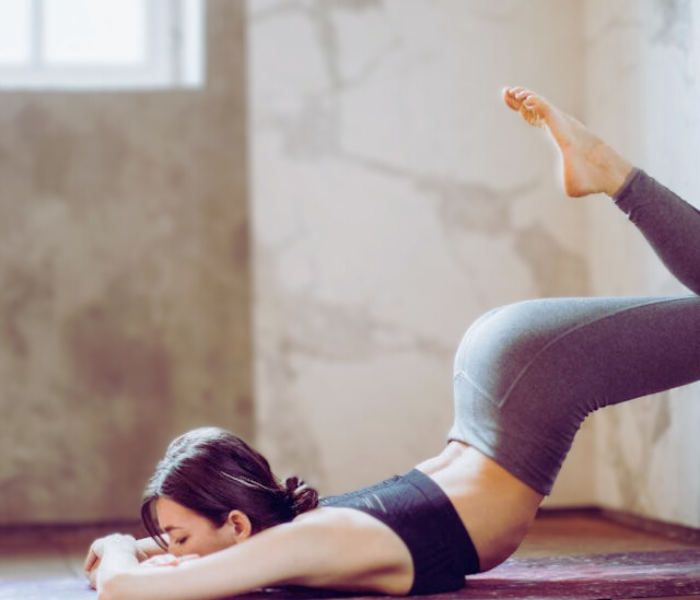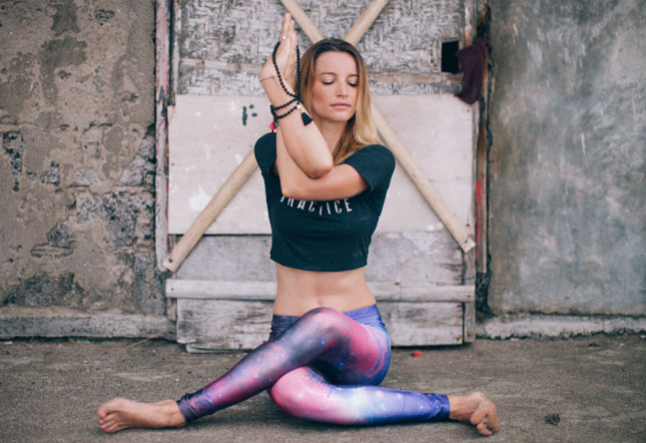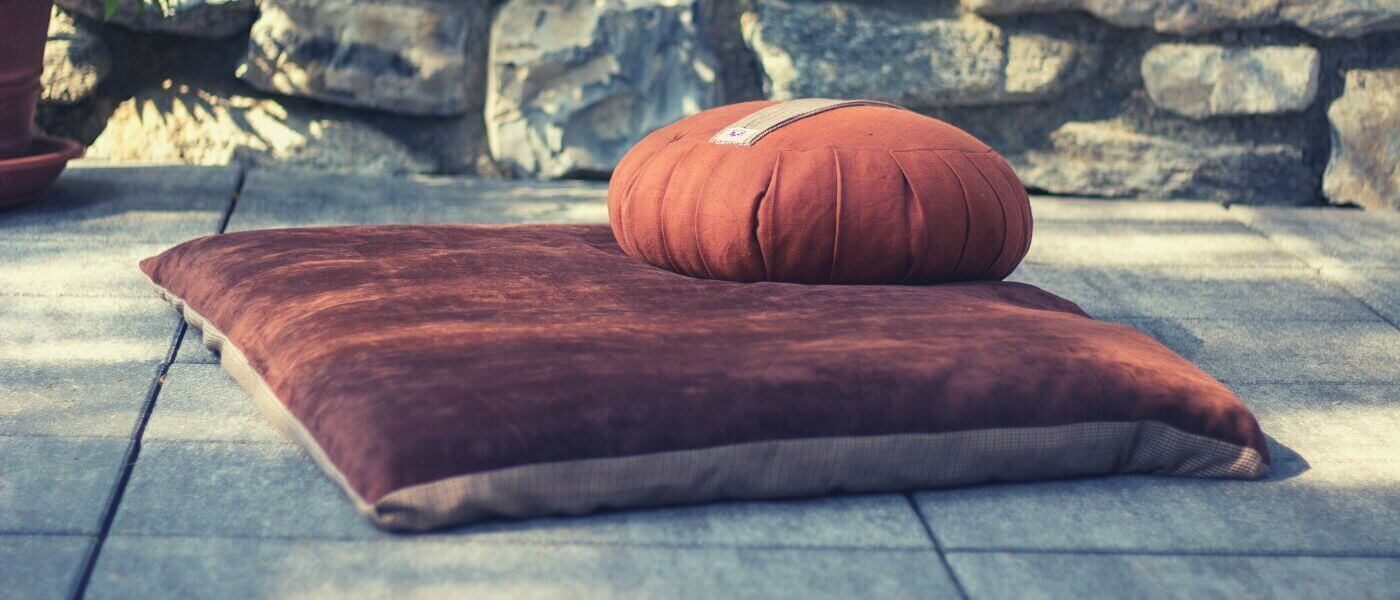reclining pigeon pose, sitting pigeon: how, what and why
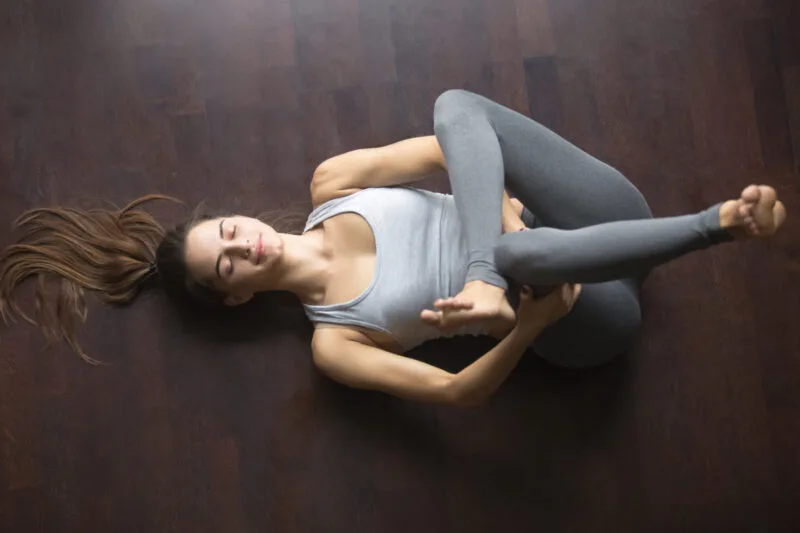
You may have heard of pigeon pose or hip-openers in general, but have you tried Reclining Pigeon? This variation is a hip-opener and a relaxing stretch combined. Reclined pigeon pose is your best bet when feeling tired, in need of a gentle hip-opener variation, or working with injuries in the knees, pelvis, or low back. Your body will thank you for taking the time to stretch and recover in this reclining yoga pose.
Supta-kapotasana – Reclined Pigeon pose sitting pigeon yoga asana
Also known as the ankle-to-knee pose, the reclined pigeon can work for everyone, including beginners, avid yogis, runners, and desk-dwellers. Reclining pigeon pose offers multiple benefits. It opens the muscles surrounding the hips, the low back, and the backs of the legs.
These muscles are often very tight from sitting upright at a desk for hours on end or constantly using them during vigorous movements, like running. When we don’t take the time to stretch out over-taxed areas properly, it can often lead to tightness and, eventually, pain. Gently stretching these specific muscle groups will let your body heal and recover properly from overuse.
Since this pose is done on your back, it is great to do as a warm-up pose, a cool-down pose, and anytime you need to refill your cup with gentle stretches and movement. Since being upside down doesn’t put any pressure on your hips or your knees, it is also a safer hip-opener if you are working with any hip instability or with a knee injury.
This pigeon pose variation also prepares you for more intense hip openers, such as resting pigeon pose (Kapotasana) and fire log or double pigeon pose (Agnistambhasana).

Start by lying down on your back with your knees bent and your feet hip-distance apart to do the reclining pigeon pose. Cross one ankle above your opposite knee, below the kneecap, and flex both feet. Make sure the center of the foot lines up with your kneecap as you pull back the toes. Keeping the hips even with each other, gently peel away the floating knee from your chest, and use your hand to add gentle pressure.
To deepen the stretch, hug this figure-four shape into your chest and wrap your hands through the figure four. You can hold behind the hamstrings, on top of the shin, or use a strap to catch your legs. Lengthen your sacrum and tailbone and press your low back into the floor. Make sure that your head, neck, and shoulders rest comfortably on the ground. Hold for five to eight calm and steady breaths. On the inhale, reach your floating knee away from you, and on the exhale, soften and mold your low back and sacrum into the floor.
Reclining Pigeon Pose Variations:
Add a blanket: if your low back and hamstrings are tight, try placing a folded or rolled up blanket under your hips. The blanket will help keep your low back and sacrum pressed to the floor. If your head or shoulders lift off the ground, add a blanket or a pillow under your head, as well, so that your head and neck can stay relaxed.
Hands-free variation with a wall: instead of using a strap or your arms to catch your legs, you can also use a wall. Set up on your back next to a wall with your feet a few inches away from the wall. Cross your ankle below the knee and step your other foot onto the wall. Keep your shins parallel to the floor. Using the wall allows your arms to relax, and you can adjust your distance from the wall depending on how open or restricted you feel in this pigeon variation stretch.
Chair variation:
- Sit upright in a chair with your feet hips-distance wide.
- Cross one ankle above your other knee and flex the foot.
- Keep your spine long.
- Lean forward over your legs to deepen the stretch in the outer hips and the low back. This move is an excellent pigeon variation when sitting at a desk.
More hamstrings variation: To facilitate a deeper hamstring stretch and low back opening, try straightening the uncrossed leg. Reach it toward the ceiling and hold that foot with your hands or with the help of a strap. Draw the foot closer to your nose to deepen both the hamstrings and outer-hip stretches.
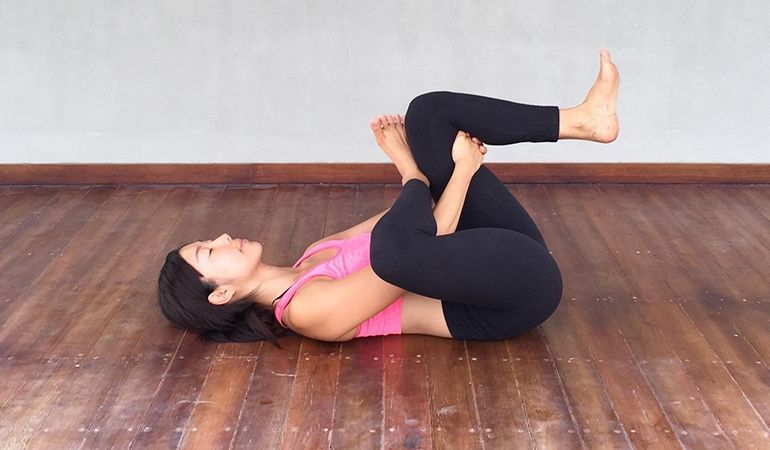
Level Up with Double Pigeon or Agnistambhasana Variations
When you are ready to add more intensity to this stretch, and your low back has enough space, you can level up with more pose variations, such as double pigeon pose. In this pose,, the added challenge comes from being seated and having both outer hips stretched simultaneously.
To try double pigeon:
- Find a comfortable seat. If you experience tightness in your low back, sit on the edge of a folded blanket.
- Stack your shins on top of one another so that one foot is above the opposite knee and the other foot is below the opposite knee.
- Flex both feet and try to have your feet past the edge of the knees.
- When looking down at your legs, they may appear as if you stacked two fire logs, one on top of the other.
If there is significant space between the top knee and the bottom ankle in your double pigeon pose, continue to sit upright to work the stretch. Use your hands to support a long spine by placing them slightly behind your hips. If the gap is around 6 inches or so, slide a blanket between your ankle and knee for support and bow forward over your shins. If the gap is negligible (3 inches or less), it most likely will disappear as you fold forward. Keep your low back flat and lean your spine forward toward your shins.
Allow your upper back and chest to soften in your double pigeon. Relax the head and the neck. If you are close to the ground, you can place supports such as a block or pillow underneath your forearms, chest, or forehead to make the double pigeon more relaxing. Hold the double pigeon for eight breaths before repeating on the other side. As you inhale, imagine your sacrum expanding as if it were lungs breathing in oxygen; as you exhale, allow yourself to sink deeper into the floor.
Also Read>>> What is an average yoga instructor salary?
Make sure you are not forcing the stretch in double pigeon. You should feel sensation but no pain, and your breath should be able to flow freely and steadily. If you notice yourself holding your breath, it’s a clear sign you may have pushed too far, so dial it back.
Benefits of Double Pigeon Pose
Besides providing a deep opening for your low back, the sacrum region, around the hips, and the inner legs, the double pigeon pose has other benefits as well. As you fold forward over your stacked shins, your internal organs will mildly compress. This pressure has detox-like and cleansing effects on your internal system. Double pigeon fold can also stimulate digestion and help move food along the digestive tract.
Energetically, the double pigeon pose has a grounding effect and can help bring the nervous system toward relaxation. To promote more peace, support your double pigeon fold with bolsters or pillows. Since this shape is close to the floor and your pelvis is firmly rooted, the double pigeon embodies the earth element and stimulates energies in the first and second chakras.
Stimulating the first chakra, the root chakra, in the double pigeon pose provides a feeling of firm support and a strong base. Stimulating the second chakra, or the sacral chakra helps to move any trapped energy in and around the big muscles of the hips. Stress often gets trapped around our pelvis, so try double pigeon pose if you feel like you are carrying extra tension or weight in your body.
Final Tips on sitting pigeon, reclining pigeon pose
As always, start your journey at the beginning. If you are new to these shapes, begin your practice with the reclining pigeon pose and notice how the pose feels. If there is a lot of space, then progress forward. If you feel a lot of restriction, spend some time with the reclining variations until you can observe less tension in the body. Be patient and kind with yourself. Day to day and week to week, these shapes can also serve as a barometer for accumulated stress or tightness from sitting, running, or other adventures.
As with any yoga or fitness routine, please make sure to consult a physician before starting a yoga practice if you have recently undergone knee, hip, or lower back surgery. People suffering from knee or back injuries should avoid practicing this stretch if it is too harsh on their bodies. If you experience numbness, tingling, or pain in your hips, legs, or back while in this pose, stop the stretch immediately.
Additionally, if you feel any discomfort while sitting in this shape or lying on the floor to do this stretch, back off and proceed at your own pace. Consider looking for a more accessible stretch to prepare your body, and, overall, listen to your body and practice what is right for you.
Also Read>>> How to become a Yoga teachers on this link.
The reclining pigeon pose is a great warm-up or cool-down pose and is easily modified into many variations. It is a great staple to add to any fitness or daily stretch routine. The shape is as versatile as the wide range of people who benefit from the activity. Because the pose gently targets the key muscles and joints in the lower half of the body, it benefits everyone, ranging from those suffering a hip injury, avid runners with sore hips from overuse, or desk dwellers with stiff hip flexors from too many hours of inactivity.
The ability to gently work into the reclining pigeon pose makes it an excellent gauge to measure your flexibility progress. It may be challenging to maintain the reclining pigeon when you initially incorporate the pose into your regimen. Still, over time, yogis can progress from preparatory stretches to prop-assisted reclined pigeon poses to a more advanced stretch, like the fire-log pose. The possibilities and benefits of this pose are incredible.
As with all physical stretches, don’t discount the mental wellness benefits of reclining pigeon pose. Connecting with your breath during the pose will allow you to feel the muscle groups being stimulated and creates the opportunity to connect deeply with your body. In yoga practice, mindfulness is the connection between our brain and the sensations in our body.
Allowing time for the brain to tune in to the subtle shifts and changes in our muscles can help bring more balance to the body and improve overall wellness and mental clarity. Pigeon pose is the perfect time to close your eyes, relax, and focus on your breathing and how the shape makes your body feel.

